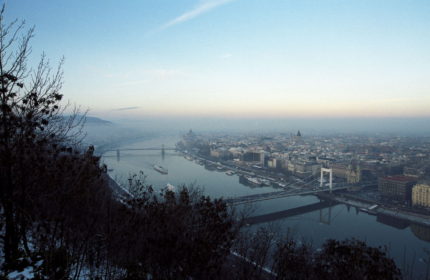
Budapest The Paris of the East
Budapest, Going Out, December 2003 – January 2004
It has been said that Budapest is an enchanting town. We couldn’t have agreed more. Sometimes called “the Paris of the East,” Budapest is composed of two opposing but complementary parts. On the hillsides of Buda are the magnificent castle, the fairy-like Fisherman’s Bastion, the citadel, and St. Matthew’s Cathedral with its gothic spires. It is the residential section of the city, very green and very pretty, with a commanding view of the Danube. Buda’s renovated old quarter is classified as a World Heritage site by the UNESCO. Its hillsides and monuments represent the history and power of Budapest and Hungary. Pest, contrary to Buda, which dates back to at least Roman times, was only a sparsely settled plain until the 18th century. It is the industrial, financial, and commercial center of town and pulses with a throbbing nightlife. To find out more about the World Heritage site, please click here.
Budapest is an incredible architectural showcase, exhibiting a variety of styles rarely seen elsewhere. Baroque, classical, romantic, Art nouveau…all exist side by side in an eclectic and harmonious style from which flows an irresistible charm. For the city is charming.
There is a lot to see in Budapest: Castle Hill and the Citadel, Fishermen’s Bastion, Turkish baths, Statute Park, Andrassy Avenue, Gellert Hill, and Heroes’ Square. The city took on its present form in the 1890’s when the Millenary Monument, the City Park, Andrassy Avenue with the Opera House, St. Stephen’s Basilica, and the Parliament building were constructed. There is a lot to do, as well. There are innumerable museums (numbering almost 200), not to mention international and Hungarian restaurants, clubs, and bars. I will try to describe some of the highlights of our visit below.
The Turkish Baths and Bath Parties
Our first weekend in Budapest started off in an unforgettable way. We happened to arrive on just the right day. There is, in fact, a techno party that takes place in one of the Turkish baths one night a month – the night before the water is changed for the month. Normally, this Turkish bath, built during the 16th century, is reserved exclusively for men, except for this one day where it is transformed into a rave party bathhouse, young 20-somethings dancing their way half-nude through the night in and around the baths.
For those of you who have never been to a bath, it is built on a thermal source, and the hot water is supposed to help heal respiratory and other problems and generally promote good health. There are close to 100 thermal springs and 12 medicinal baths in Budapest, the largest quantity of any capital in the world. 19 million gallons of thermal water rise to the surface of Budapest daily. Tourists and Hungarians alike frequent the baths, although it is generally the older Hungarians who go, especially when it is prescribed by their doctor for medical reasons.
The bath where the rave party was held had three main rooms. The first was an entrance hall with a Romanesque bronze statue in the center which was transformed into a bar and dancehall with a DJ. The second room is a large rectangular room with a large swimming pool that has a domed ceiling and a balcony, along with a large screen showing moving images. The music is faster in this room, where many people dance either in the shallow end of the pool or alongside the pool. The last room is where there are hot baths – five in all. A larger bath is located in the center of the room, about 100°F, and four smaller baths of various temperatures encircle this pool. The ambiance is more relaxed – trance or chill-out music. It is hot enough that when you enter the room, all you see is vapor rising from the baths, swirling upwards towards the domed ceiling. You see the outline of figures through a steamy haze. Because your sense of vision is lessened, your sense of hearing and touch become heightened: you mostly feel the hot water and hear the beat of the music. As people become inspired, they start a whirlwind of movement in the bath, moving faster and faster in a circular fashion. Because the bath is relatively small, if you are inside, you get caught up in the movement and everyone circles together, feeling the hot water, the music, and the dim lights piercing the steamy air. This room closes first, as the staff must clean the water and have it ready for opening the same morning at 6:00 AM. Then there is a mass exodus towards the other pool, where the water is colder and the music faster. As you dance poolside, you watch either the swaying bodies on the other side of the pool or the screen showing varied images, such as the one showing images of ex-Communist leaders standing before masses of the people – only with their heads replaced by the heads of pink elephants. Each one can decipher for himself what it is supposed to mean – if anything at all…
After the bath party, we decided there was no way we could miss going to a bath during the daytime to see what it was all about. We had been told that it is an absolute must on any trip to Budapest, and Jeff – a Frenchman living in Budapest – had told us about an outdoor bath that is excellent in the wintertime, especially if there is snow on the ground. When we went, there was no snow, but it was still an incredible experience to be sitting outside in a bath in 100° water during the winter when the outside air was about 30°. Steam rose all around, making for an especially beautiful sight at the end of the afternoon when the sun set. The largest thermal spa and bath center in Europe was actually in the City Park only a ten-minute walk from our hostel, so it was this one that we tried out. It is also supposed to be one of the best ones in the city. In addition to the many thermal baths, it is also in the exceptional setting of a castle built at the beginning of the 20th century. A thermal bath in a palace. How much better can it get?
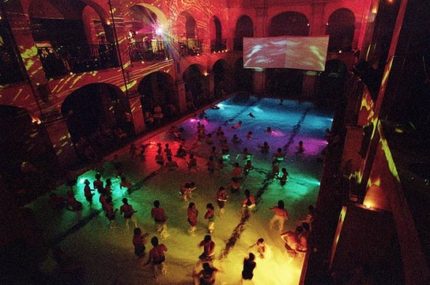
Cinetrip Rave Party in Turkish bath
They recommend that you get out of the hot pool after about twenty minutes, and I thought I could surely stay longer in the wintertime. After all, it was below freezing outside. But I was wrong. We stayed about that long – I stood mostly under the fountains (for a free massage!), and Stephane watched the old men playing chess on the steps – and then we were ready to get out and move to a cooler pool. There were a lot of baths inside the palace, all of various temperatures, ranging from about 45° to 100°F. Plus a sauna and steam room which measured about 160°F.
It was my first experience in a bath (aside from the bath party), as well as in a sauna or steam room. I didn’t realize saunas and steam rooms were so hot! I preferred the moister air of the steam room to the dry air of the sauna. It seemed crazy to me. People say that saunas and steam rooms are supposed to have a curative effect, but it seemed crazy to stay in a room where the air you breathed burned the insides of your nostrils and you turned bright red with extreme heat. I stayed in for a short while, only because it was supposed to be “good” for me, but I couldn’t help looking at the old men standing across from me, dripping and turning fire-engine red. I know I must have looked the same. I couldn’t help thinking that we were like red lobsters being dropped in a pot of boiling water. But voluntarily.
Afterwards, you are supposed to jump in a pool of cold water (freezing by comparison!) to cool down your body and finish the cleansing process. Jeff had told us that it was better to jump in quickly, then not to move at all, so that the water around you heated up. I jumped in, and only with an incredible determination, moved not an inch. In fact, I stayed much longer than any one else, who jumped in and out again immediately. But I was sick, and I was told that this was supposed to cleanse your system. So I forced myself to stay in for what seemed like forever. Afterwards, someone told me that you didn’t need to stay in for any length of time. So this self-inflicted torture was perhaps useless. Oh well, it was an experience anyway. Afterwards, I didn’t even want to get in the hot baths anymore – they all of a sudden seemed too hot.
There are only a few co-ed baths in the capital; most are single-sex. We heard about some of the experiences that our fellow travellers had, and some were quite funny. Probably the best was Nathan’s experience in one of the baths one afternoon, when he was approached at different times by different men. We had heard that the all-male baths were sometimes like pick-up scenes. To begin with, people do not wear bathing suits in the single-sex baths; they are given a towel to sit on. So, Nathan decides to try one out, and when he comes back, he tells us about how one old man inched closer and closer to him as he tried to move away. Then, the man starts playing “footsie” with him, and as Nathan tries nonchalantly to ignore him, the man – and this is a quote! – “took his pinky and twittled nipple.” That’s when Nathan decided to get outta there, and try the co-ed baths next time around!
Caving under Budapest
Another unique feature of Budapest is its interconnected cave systems, which lie beneath the hills of Buda and which were formed by thermal waters. Some of these caves, which can be up to several kilometers in length, can be visited with a guide. We took a tour one afternoon. You dress up in overall pants and a jacket to protect your clothing and don a helmet to protect your head. Then you follow your guide and descend into the earth by a ladder. At the beginning of the tour, we were given a choice of difficulty: easy, medium, or difficult. Our group chose “difficult.” And they weren’t kidding. It took us over three hours to advance only ½ a mile. We squeezed through passageways with names like “The Wedgie,” “The Birth Canal,” and “The Sandwich.” The names alone ought to give you an idea of what it was like.
I actually got stuck in “The Wedgie.” We were supposed to go through on our left side, left arm above our heads, completely sideways. I wasn’t very good at following instructions, however. I turned my head to look forward to see where I was going. Instead, my helmet got stuck and I ended up in complete darkness. Gravity tried to pull me downwards, but the stubborn helmet fell over my eyes and wouldn’t let me go any farther. I couldn’t budge an inch or see a thing. I couldn’t get the helmet off right away, either, as the strap was pulled tight by the downward movement. I’ve never felt claustrophobic before, but I’m sure I had a moment there! I finally managed to extricate myself – thank God! – after what seemed like ages. It’s amazing how many thoughts can flood your brain at a moment like that when you think you’re going to be stuck there forever. It didn’t help that I was the smallest one, either. Everyone got a pretty good laugh out of it because I was the only girl and the only one that got stuck. I tried to explain that all the helmets were the same size, regardless of head size, but it was much more fun to laugh at me!!
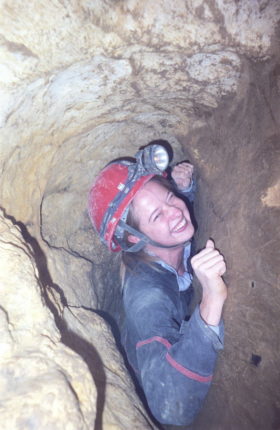
Sheri stuck like a “wedgie”
Stephane had a moment of inspiration, too. He said it was “Tight as a carrot!” Tight as a carrot?! Whoever heard of that? I tried explaining to everyone that it was just some crazy French expression, and that all French expressions somehow manage to involve food. But Stephane said no, it wasn’t an expression, but that he had just thought it up at the moment. And he thought it was very logical, too. Tight as a carrot! Why, carrots grow in the ground and get stuck. Just like I was in a cave in the ground and stuck. We all looked at each other and laughed. Crazy French! Only the French could think of something like that!
The Flea Market and the Christmas Market
We visited the Flea Market on a Saturday afternoon in the park and saw Hungarian and Middle eastern sabers, old bank notes from Hungary, Romania, and Bulgaria, stamp collections, books, videos, new and used jackets, clothing and boots, jewelry, perfume, and toothpaste. There was a variety of people. Stephane thought the whole experience was depressing, but I didn’t particularly think so.
We also visited the Christmas Market in town, which was our favorite of all the ones we’ve visited. It was relatively large, and many of the goods were artisanal. We found Hungarian instruments, leather purses and wallets, amber and bead jewelry, homemade pastries, sausages, and hot wine. The first night we went, there was a four-piece band playing traditional Hungarian music: string bass, 2 violins, and a female singer. We went the following week and saw two different bands playing on the small stage not far from the Christmas tree. The first band likewise played traditional music – there was a fiddle, a small drum, a recorder, and an instrument similar to a banjo. Two groups of revelers danced in circles, the children in the inner circle and the adults in the outer circle.
The second band was a Bulgarian singing group that performed traditional Bulgarian folk music and dance. The men singing on stage wore gray fur hats with strings of popcorn and a red flower around the crown. Also, heavy knit stockings, sandals, knickers, and short suede vests that they wore open over white shirts. And a big gray rug on top to keep warm. The women dancers wore a red flower in their hair and a red dress and apron with tiny embroidered delicate flowers. They wore a red shawl, knitted, over their shoulders, and long flowing peasant sleeves. Also pointed sandals and knit stockings with tiny red flowers on the foot of the stockings. Three men played an accordion, a drum, and a guitar, and the men sang a deep, resonating song which doesn’t vary much in range.
The five female dancers danced in a coordinated line, legs bent at the knee, taking wide steps, their hands at their hips. Every once in a while, the women give a high-pitched shout. Then a line of men joined in – four of them – their arms around each other’s shoulders, also taking huge steps in the air. After a while, they joined in a circle, holding hands, the leader waving a handkerchief in the air. The women continued to give little shouts every now and then. The dance is not what you would call romantic or beautiful, but it is traditional group dancing, and highly spirited and lively. The music got more lively towards the end and reached a crescendo, when many of the crowd joined in.
We went to the large mall in center city as well, looking for a Christmas gift for our nephew’s first Christmas. Many of the stores were brand-name, like Levis or Diesel. The prices were similar to what we’d pay at home. I don’t know how they can afford to charge prices like that over here. Music played over a loudspeaker at the mall – American pop music and English Christmas carols, such as “White Christmas” and “Santa Baby.” A little part of Christmas away from home. It’s funny: we noticed that in the city, as well as in the countryside, some people wear snowsuits – even when it’s not snowing. I suppose the cold weather is reason enough, but it was kind of funny seeing adults walking around the mall in their suits.
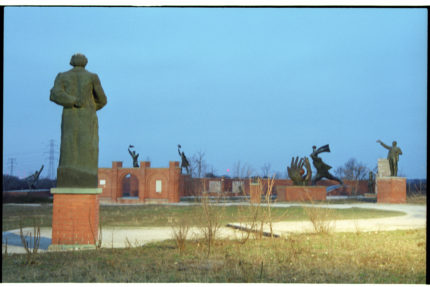
All old statues from the communist era were relocated in this park
Statue Park…A Communist Cemetery
Another unique feature of Budapest is its Statue Park, a park on the outskirts of Budapest which was created when statues from the Communist times were removed from the public parks and streets of the city. In short, it is a glance behind the Iron Curtain: statues of Lenin, Marx, the Soviet Heroes and the Communist Martyrs. The idea came in 1989-90 from a Hungarian literary historian, who had the idea to create a park or cemetery for all the former Communist statues. Each statue was voted on one by one. The park was started in 1994, but was never finished because funding dried up. It is in a barren wasteland surrounded by a wire fence, on the other side of which is a street of unhappy-looking houses.
The architect says it symbolizes dictatorship but also democracy, because democracy allows you to think freely about dictatorship (or democracy…or anything!) He says it is about impotence, agony, despair. “Inevitably, a tourist coming from a foreign country, to whom dictatorship means nothing more than at the maximum a reading experience, very different thoughts arise than a person with a tragic past, who lived here, lived through hard times, carrying the drama of their own broken life under these statues into the park. Silence is common.”
The souvenir shop carries unique memorabilia such as medals, T-shirts with “McLenin” written under the golden arches, and CDS such as “The Best of Communism, Vol.1&2 – Revolutionary Songs.” The loudspeaker at the shop plays music from these CDs.
A Little Touring…
We visited historical buildings in the city as well. For example, the McDonald’s restaurant across the street from the main commercial mall, which is reputed to be the most beautiful of all the Golden Arches in the world! In a slightly different style, we also saw the Dohany Street Synagogue, Parliament, Heroes’ Square, and St. Stephen’s Basilica. The Synagogue is the largest in Central Europe, and very beautiful. The Basilica, built in the neo-Classical style, is the largest church in Budapest and its 96-meter-high dome affords a view over virtually the entire city. Each interior wall is made of marble: green, gray, or maroon. Rather than being cold, as marble can sometimes be, it is actually quite warm and welcoming. We saw it during the Christmas season, so it was decorated with evergreen trees and white lights. It is perhaps the prettiest cathedral we have seen thus far. We strolled around the streets of the inner city, window shopping while others went about making their Christmas purchases. We admired the trappings of an Oriental furnishings store, which featured Persian rugs and a rug made from an entire Tiger skin, which sat growling at us from behind the glass storefront window.
We also walked around the City Park next to our hostel in Pest. It was established in the 19th century and is a wonderful place for a moment in nature away from the bustle of the city. Magnificent monuments and buildings were built here: the Museum of Fine Arts, the Palace of Arts, the Millenium Memorial, and the Disney-like Vajdahunyad Castle. Heroes’ Square is located at one end of the park and is the most spectacular square in the capital. It was built to commemorate the 1000 year anniversary of the conquest of Hungary. Its 108-ft.-high column in the center of the Millenium Memorial can be seen from afar. On either side are quarter-circular colonnades, monuments to great figures in Hungarian history, and Palace of Arts and Museum of Fine Arts. Since the 1956 insurrection, it has been the place where all protests and marches start.
As I mentioned earlier, Budapest has an incredible mélange of architectural styles. We marvelled at how the styles changed house by house, building by building. Despite evidence by daytime of some work that needed to be done, the city became glittering at nighttime, its palaces, bridges, and monuments shown off to their best.
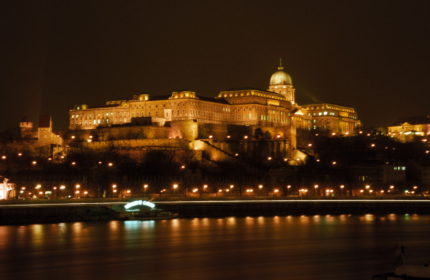
Budapest by night
The panorama of the famous Chain Bridge, with the Buda Castle rising above on the hillsides, has drawn many visitors to the city. The oldest bridge in Budapest and a symbol of the city, it is even prettier by nighttime, and the view it offers of the Castle Quarter, with the Gellert statue, the Castle, and the Fishermen’s Bastion on the Buda side and the Parliament on the Pest side is breathtaking. Its spires extending 96-m. into the air, the Parliament is fairy-like, as a castle out of a fairy tale. In fact, this entire quarter by the river is an outstanding testament to how man has successfully and harmoniously integrated his architecture, cities, and life into the natural habitat of the river and the surrounding region.
Budapest is renowned as being the location of one of the most beautiful World Heritage sites. The panorama of the city as it unfolds from the Chain Bridge, the Citadel, or the Castle Quarter is unparalleled. In addition, it has Europe’s largest Parliament, the largest functioning synagogue, and the continent’s first underground railway. The city justly holds the title “Queen of the Danube.” The charm of the city lies in its pleasing harmony of differing architectural styles combined with the baths, the cafes and bars, and the renowned Hungarian hospitality. It all makes for an unforgettable experience.


